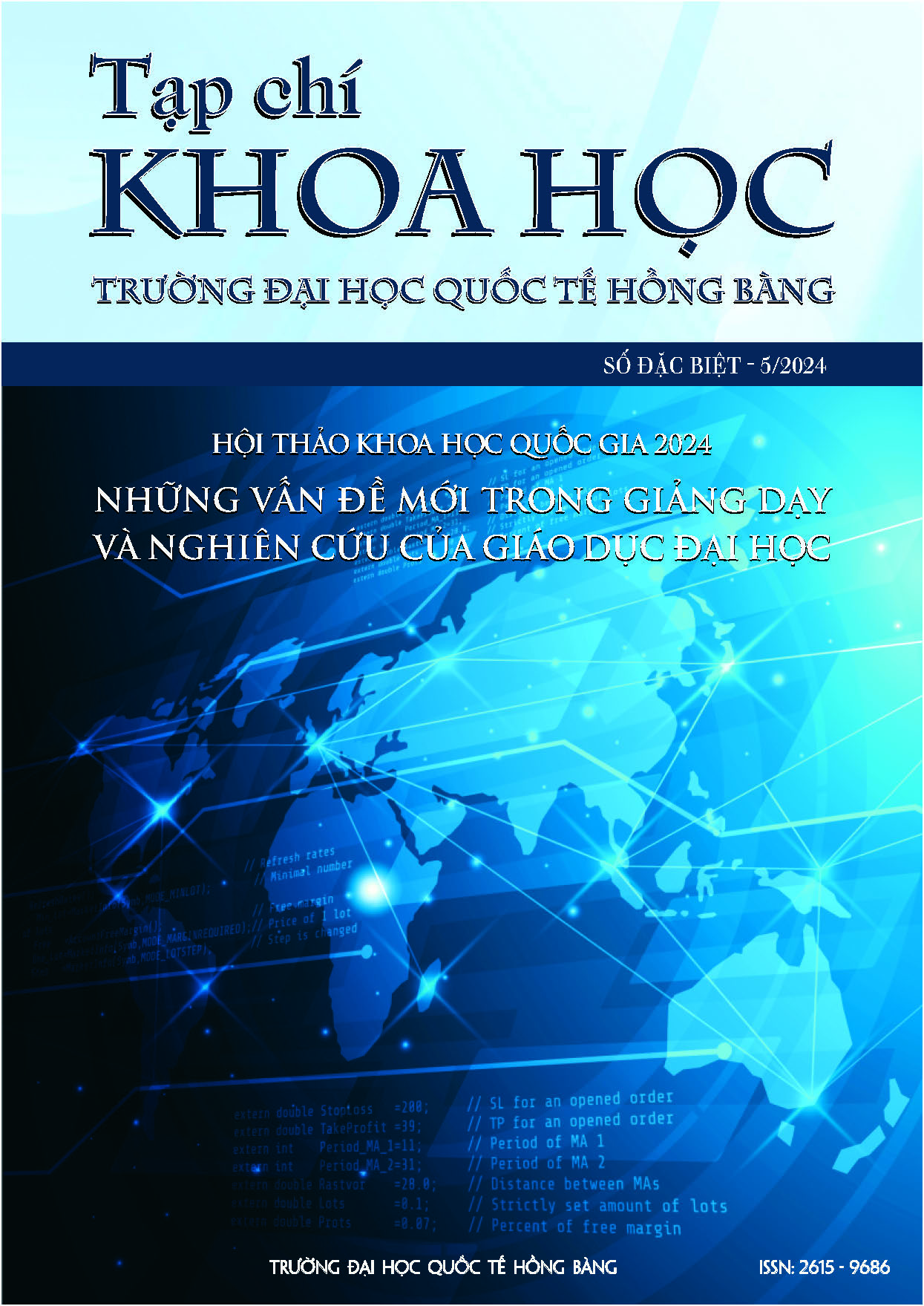ẢNH HƯỞNG CỦA PHƯƠNG PHÁP VIẾT CỘNG TÁC TRONG KHÓA HỌC TIẾNG ANH TĂNG CƯỜNG ĐỐI VỚI KHẢ NĂNG VIẾT CỦA SINH VIÊN TRƯỜNG ĐẠI HỌC QUỐC TẾ HỒNG BÀNG
Các tác giả
DOI: https://doi.org/10.59294/HIUJS.KHQG.2024.011Từ khóa:
viết cộng tác, bài viết, lợi ích, sinh viên năm nhất, kỹ năng viếtTóm tắt
Nghiên cứu kết hợp định lượng định tính này đánh giá mức độ ảnh hưởng của phương pháp viết cộng tác (CW) để cải thiện chất lượng bài viết của sinh viên không chuyên ngành tiếng Anh của Trường Đại học Quốc tế Hồng Bàng (sau đây gọi tắt là HIU). Kết quả nghiên cứu dựa trên bài viết của trên 46 sinh viên năm nhất chỉ ra rằng phương pháp CW ảnh hưởng tích cực đến bố cục, nội dung và ngôn ngữ trong bài viết đoạn ngắn của sinh viên. Bên cạnh đó, kết quả từ phỏng vấn nhóm sinh viên tham gia can thiệp quan điểm tích cực của sinh viên về phương pháp viết cộng tác. Tất cả 6 sinh viên tham gia phỏng vấn đều thích thú khi được làm việc với bạn cùng lớp và cho rằng điều đó giúp họ có nhiều ý tưởng khi viết, từ đó sẽ trao đổi và tìm ra ý tưởng tốt nhất. Bên cạnh đó, sinh viên cũng thấy được sự phát triển một số kỹ năng mềm quan trọng như kỹ năng giao tiếp, sự tự tin khi giao tiếp, và kỹ năng đàm phán. Dựa trên kết quả nghiên cứu, việc ứng dụng phương pháp CW trong các lớp tiếng Anh không chuyên, tập trung vào sinh viên tại HIU đã được bàn luận.
Abstract
The present study evaluates the capability to implement Collaborative Writing ( CW) to enhance students’ writing performance at Hong Bang International University ( HIU). Findings from a sample of 46 university students showed that CW could influence the students’ writing performances, in terms of organization, content, and language use, increasing the overall score of their writing work. Additionally, the results from interviews with the experimental group showed positive attitudes toward the use of CW. All 6 interviewees enjoyed collaborations with their peers and stated that they could have a collection of ideas to write, idea exchange, and discover the most optimal concepts. Furthermore, they could improve some of the important soft skills such as communication skills, increasing confidence in communication, and negotiation skills. Based on the study’s results, implications of the use of CW in EFL writing classes were discussed, focusing on students at HIU.
Tài liệu tham khảo
[1] D. Johnson and R. Johnson, "Making cooperative learning work," Theory Into Practice, vol. 38, pp. 67-73, 03/01 1999, doi: 10.1080/00405849909543834.
DOI: https://doi.org/10.1080/00405849909543834[2] N. Storch, "How Collaborative Is Pair Work? ESL Tertiary Students Composing in Pairs," Language Teaching Research, vol. 5, no. 1, pp. 29-53, 2001.
DOI: https://doi.org/10.1177/136216880100500103[3] V. P. H. Pham, "The Effects of Collaborative Writing on Students’ Writing Fluency: An Efficient Framework for Collaborative Writing," SAGE Open, vol. 11, no. 1, 2021, doi: 10.1177/2158244021998363.
DOI: https://doi.org/10.1177/2158244021998363[4] N. Storch, "Collaborative writing in L2 contexts: Processes, outcomes, and future directions," Annual Review of Applied Linguistics, vol. 31, pp. 275-288, 2011, doi: 10.1017/S0267190511000079.
DOI: https://doi.org/10.1017/S0267190511000079[5] A. Fernández Dobao, "Collaborative writing tasks in the L2 classroom: Comparing group, pair, and individual work," Journal of Second Language Writing, vol. 21, no. 1, pp. 40-58, 2012, doi: 10.1016/ j.jslw.2 011.12.002.
DOI: https://doi.org/10.1016/j.jslw.2011.12.002[6] A. F. n. Dobao and A. Blum, "Collaborative writing in pairs and small groups: Learners’ attitudes and perceptions.," System, vol. 41, no. 2, pp. 365-378, 2013, doi: http://dx.doi.org/10.1016/j.system.2013.02.002.
DOI: https://doi.org/10.1016/j.system.2013.02.002[7] P. B. Lowry, A. Curtis, and M. R. Lowry, "Building a taxonomy and nomenclature of collaborative writing to improve interdisciplinary research and practice," The Journal of Business Communication (1973), vol. 41, no. 1, pp. 66-99, 2004.
DOI: https://doi.org/10.1177/0021943603259363[8] L. Yang and P. Ng, "An exploration of peer review in EFL writing classrooms in China," Assessing Writing, vol. 28, pp. 22-33, 2016.
[9] I. Elola and A. Oskoz, "Collaborative Writing: Fostering Foreign Language and Writing Conventions Development," Language Learning and Technology, vol. 14, 10/01 2010.
[10] A. Talib and Y. L. Cheung, "Collaborative Writing in Classroom Instruction: A Synthesis of Recent Research," The English Teacher, vol. 46, pp. 43-57, 08/01 2017.
[11] J. Ortega Martín, I. B. Hameleers, J. M. Torres, and A. Moreno Guerrero, "A Comparison between Collaborative and Individual Writings in Promoting Motivation and Language Acquisition," Sustainability, vol. 12, pp. 1-11, 09/25 2020, doi: 10.3390/su12197959.
DOI: https://doi.org/10.3390/su12197959[12] M. Sarkhosh and S. Najafi, "Collaborative and Individual Writing: Effects on Accuracy and Fluency Development," Porta Linguarum, vol. 3, pp. 27-42, 07/11 2020.
DOI: https://doi.org/10.30827/portalin.vi33.18124[13] N. Hong Anh, H. Lam, and S. Nguyen, "A Quantitative Study on Evaluation of an Intensive English course: Voices of non-English-major Students," VNU Journal of Foreign Studies, vol. 37, pp. 140-154, 03/31 2022, doi: 10.25073/2525-2445/vnufs.4726.
DOI: https://doi.org/10.25073/2525-2445/vnufs.4726[14] J. W. Creswell and T. C. Guetterman, Educational research: planning, conducting, and evaluating quantitative and qualitative research, Sixth Edition. New York, NY: Pearson (in English), 2019.
[15] Z. Dörnyei, Research methods in applied linguistics. New York, NY: Oxford University Press, 2007.
Tải xuống
Tải xuống: 206











